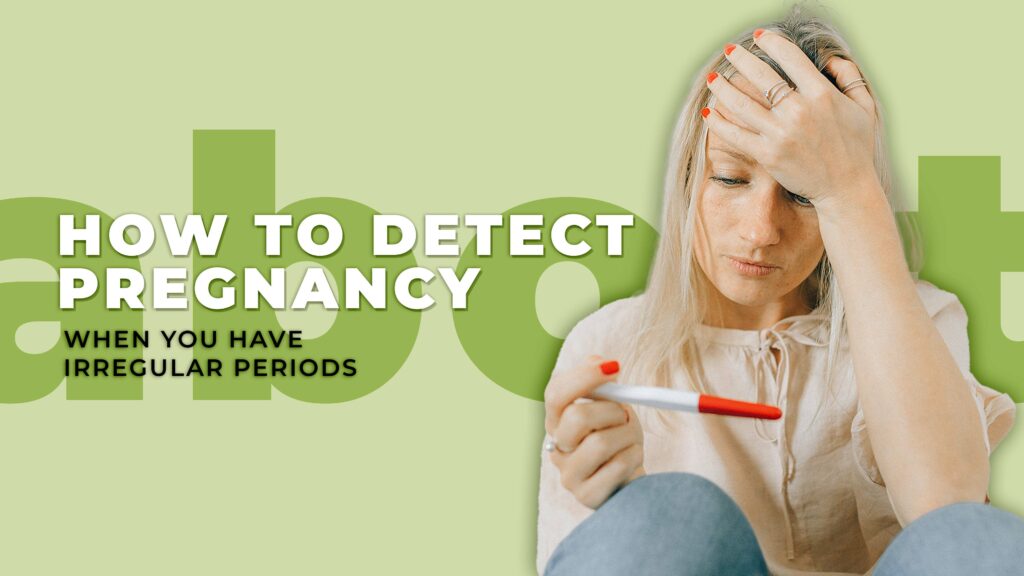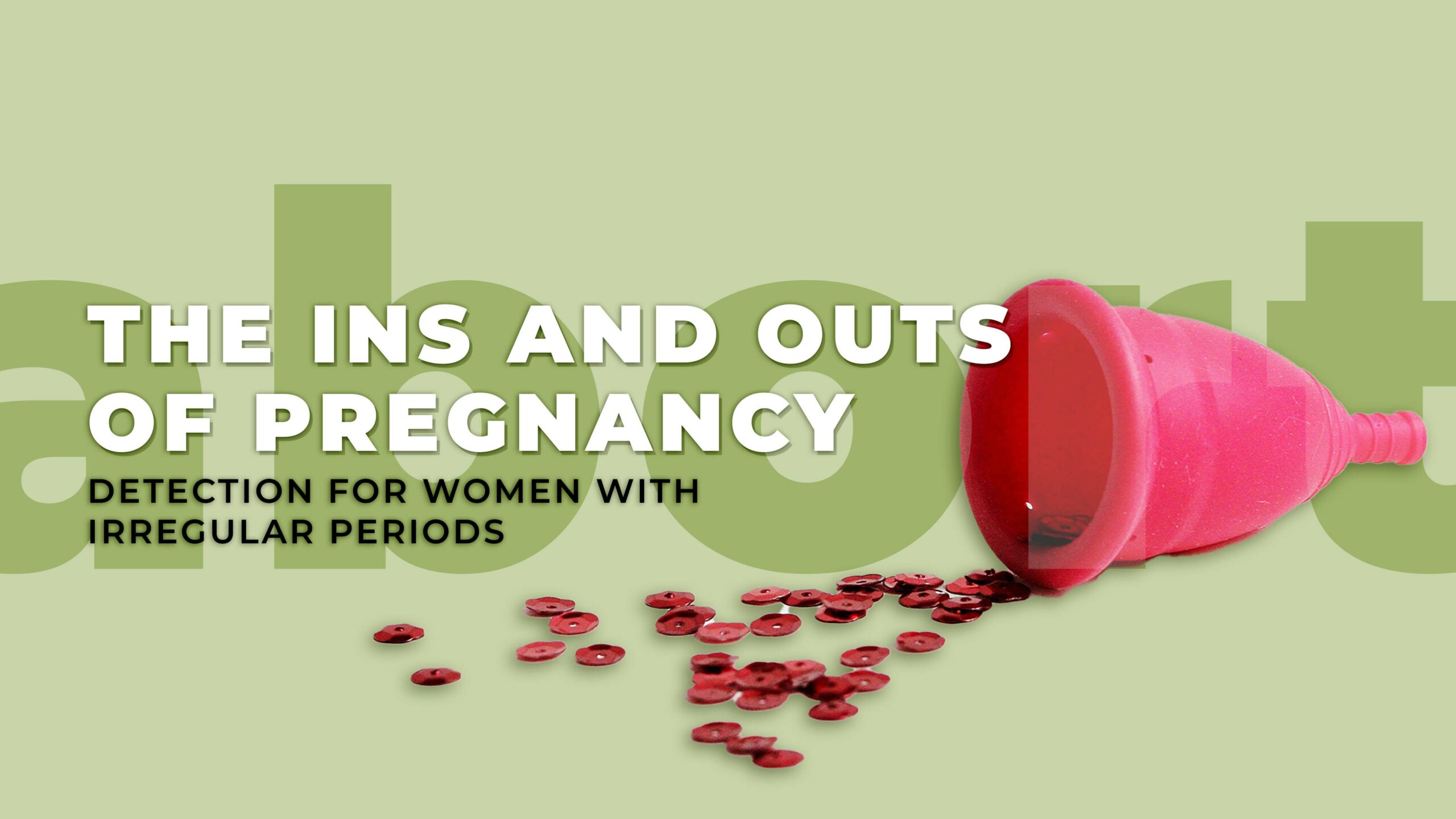The menstrual cycle is an essential part of a woman’s life. It’s closely tied to her physiology, overall health, and well-being. Any dissension in its wonted mechanism can significantly alter a woman’s health and cause psychological stress. Being closely hinged to the homeostasis of the human body and having an involuted mechanism, its understanding is imperative to maintain haleness.
Irregular periods are something every woman faces in their lifetime. They can be a source of stress, discomfort, and speculation. While most of the time, they might not be due to an underlying disease, they can sometimes point toward a pathology. Having an irregular menstrual cycle can also make it harder to detect pregnancy as the most elemental form of diagnosis of pregnancy remains to notice missing periods.
Pregnancy is a significant aspect of human life; thus, its correct diagnosis is of paramount importance. In a study, the Alan Guttmacher Institute, New York, found that the proportion of infants born with a health disadvantage was significantly lower if the pregnancy was intended than if it was mistimed or not wanted(1). Unplanned pregnancies can be oveelming due to the sheer amount of responsibility and physical prowess required to manage them. Not only does it pose unwarranted health concerns, but it also has financial ramifications. Thus, its detection is extremely important, especially in women with irregular cycles.
Since menses is a multifaceted topic with cardinal implications, addressing any irregularity or abnormality associated with them is essential. In this article, we will discuss the physiology of periods, reasons for irregularity, and possible modalities to improve menstrual health.
Physiology of Periods
Menstruation usually occurs between the age of 10 to 16, depending on the individual’s social, geographical, and physiological factors. Factors like environmental conditions, nutrition, physical activity, geographic location, urban or rural residence, health status, psychological factors, blindness, body mass index (BMI), family size, socioeconomic status, and parental educational level also affect the age of menarche(2).
Menstruation is divided into two phases: the follicular/proliferative phase and the secretory/luteal phase. (3)
- Follicular Phase- The follicular phase begins on the first day of menses and ends at ovulation. The increased FSH(Steroid Hormone) at the start of the cycle stimulates the growth of the possible ovarian follicles, which eventually start developing and releasing estrogen. On day 8, one follicle exerts its dominance by promoting its growth and suppressing the maturation of the other ovarian follicles, thus becoming the dominant follicle. The increasing concentration of estrogen initiates the release of LH, also known as LH surge. This surge leads to ovulation marking an end to the proliferative phase.
- Luteal Phase- Luteal phase is defined as the period from ovulation to the beginning of the menses. Its 14 days is relatively the same in all women, unlike the follicular phase, where duration is more dynamic. After ovulation, the follicle releases an ovum, the female haploid germ cell, while the remnant part turns into the corpus luteum. The corpus luteum releases large amounts of progesterone which facilitates the growth and thickening of the endometrial layer for the implantation of the possible embryo. If there’s no fertilization, the corpus luteum degenerates, leading to falling in progesterone, thus ensuing menses.
What Can Lead to Irregular Periods?

- Obesity- Increased body weight has been documented as a risk factor for amenorrhea in various high-quality studies. A study by the Huddinge University Hospital, Sweden, found obese women to be at significantly higher risk of developing menstrual problems(4). The increased adipose tissue releases a number of bioactive molecules, namely adipokines, that variably interact with multiple molecular pathways of insulin resistance, inflammation, hypertension, cardiovascular risk, coagulation, and oocyte differentiation and maturation(5). Dietary improvement and regular exercise have been shown to improve general and sexual health.
- Metabolic Disorders- Diseases like Diabetes and CVD can also alter the hormone profile of women, thus causing menstrual irregularity. A 2016 study found metabolic syndrome and its components (high waist circumference, high triglyceride levels, and low high-density lipoprotein cholesterol levels) to be significantly associated with menstrual irregularity in women of reproductive age(6).
- Polycystic Ovarian Disorder– The female hypothalamic–pituitary–ovarian (HPO) axis is a harmonized and regulated cycle ultimately responsible for the reproduction and survival of the species. The HPO axis responds to both intrinsic signals (i.e., hormonal and neuronal) and extrinsic factors (i.e., environmental influences) (7). Polycystic ovary syndrome (PCOS) is a disorder characterized by hyperandrogenism. This hyperandrogenism affects the HPO axis and causes amenorrhea or chronic anovulation.
- Smoking- Smoking releases many free radicals, which cause oxidative degradation throughout the body. Many studies have conclusively marked it as a risk factor for irregular menses. California Department of Health Services, Emeryville, USA, found with greater cigarette smoking. There was a possible increased risk of anovulation and a short luteal phase(8).
- Alcohol– A review by the Alcohol and Drug Abuse Research Center, Harvard Medical School, found alcohol abuse and alcoholism to be associated with a broad spectrum of reproductive system disorders such as amenorrhea, anovulation, luteal phase dysfunction, and ovarian pathology(9). Indiscriminate consumption of alcohol causes metabolic dysfunction, which might lead to menstrual issues.
- Stress- Stress-induced amenorrhea, also known as hypothalamic amenorrhea, is one of the most common causes of irregular periods. It accounts for the reproductive dysfunction seen in undernutrition, excessive exercise, severe emotional stress, and chronic disease(10). When the body is under stress, it allocates its resources to survival tools, thus inhibiting the reproductive system. Excessive exercise, anxiety, malnutrition, and eating disorders; all contribute to bodily stress.
How to Detect Pregnancy When you Have Irregular Periods?

Due to uncertainty regarding cycle periodicity, duration, and intensity in women with irregular menses, the detection of pregnancy by noticing changes in the cycle remains improbable.
Though various tests and investigations can help make a correct diagnosis, relying on them might always seem inconvenient and fiscally challenging.
Here are a few bodily changes and signs one can notice as signs of early pregnancy:
- Swollen or tender breasts- When fertilization occurs, the fertilized ovum releases human chorionic gonadotropin, which facilitates the stability of the corpus luteum. As discussed above, the corpus luteum secretes large amounts of progesterone, increasing the blood flow to the breasts. This increased blood flow causes the breasts to feel Swollen, sensitive, and tender.
- Implantation bleeding- The embryo implantation in the uterine wall can sometimes lead to minor bleeding, also called spotting. One might notice light staining during unsuspected dates.
- Nausea and Vomiting- Nausea and vomiting are common experiences in pregnancy, affecting 70–80% of all pregnant women(11). Though the cause is generally unknown, it’s usually attributed to human chorionic gonadotropin.
- Food Cravings- Due to the increased demand for energy and hormonal changes, food cravings become highly prevalent in pregnancy. Both appetite and demand for food increase significantly.
- Moodswings- Since the hormone profile changes drastically during pregnancy, the mind becomes susceptible to unwarranted mood changes and other neurotic symptoms.
- Fatigue- One might also feel tired and exhausted due to increased energy expenditure.
- Headache and Increased Urination- Blood volume increases significantly within the first few weeks of gestation and increases progressively throughout the pregnancy (12). This leads to increased urine output and vasodilation of cerebral blood vessels causing headaches.
Despite these symptoms and bodily changes being grand in number, none present with an objective diagnosis. It is recommended to use FDA-approved pregnancy tests to confirm and correlate the symptoms for a correct diagnosis.
Various urine-based pregnancy tests are available in the market, which is both economical and sensitive. An objective investigation-based diagnosis should not be substituted with self-reported symptoms.
Urine Pregnancy Test
Most pregnancy tests aimed at the general public are based on the presence of human chorionic gonadotropin in urine. Other pregnancy-specific materials have been proposed as pregnancy tests, but none can better the sensitivity and convenience offered by the immunoassay of HCG(13).
HCG from the implanted fertilized egg first appears in maternal blood around 6-8 days following fertilization; the levels rise rapidly to reach a peak at 7-10 weeks. Most current pregnancy kits available in the market may reveal positive results 3-4 days after implantation; by 7 days (the time of the expected period), 98% will be positive.
When to Test for Pregnancy When One has Irregular Periods?

The U.S. Department of Health & Human Services recommends one count 36 days from the start of their last menstrual cycle or four weeks from the time they had sex. At this point, if one is pregnant, their levels of hCG should be high enough to detect the pregnancy.
Conclusion
Menses are integral to a woman’s health; any irregular cycle can be agonizing and distressing for the affected. Irregular periods can be due to a multitude of reasons, such as overexercising, anxiety, smoking, alcoholism, diabetes, obesity, etc. Albeit the reasons are many, they all present a very major problem which is the detection of pregnancy in both women who are trying to conceive and those who are not.
Symptoms like swollen breasts, headaches, implantation bleeding, nausea, fatigue, and food cravings can provide a subjective idea about early pregnancy, but they are not completely accurate. When in doubt, a standard urine-based pregnancy test should be employed to detect early pregnancy.
References:
- Kost K, Landry DJ, Darroch JE. The effects of pregnancy planning status on birth outcomes and infant care. Fam Plann Perspect. 1998 Sep-Oct;30(5):223-30. PMID: 9782045. https://pubmed.ncbi.nlm.nih.gov/9782045/
- Ramezani Tehrani F, Mirmiran P, Gholami R, Moslehi N, Azizi F. Factors influencing menarcheal age: results from the cohort of tehran lipid and glucose study. Int J Endocrinol Metab. 2014 Jun 10;12(3):e16130. doi: 10.5812/ijem.16130. PMID: 25237321; PMCID: PMC4166004. https://www.ncbi.nlm.nih.gov/pmc/articles/PMC4166004/
- Reed BG, Carr BR. The Normal Menstrual Cycle and the Control of Ovulation. [Updated 2018 Aug 5]. In: Feingold KR, Anawalt B, Boyce A, et al., editors. Endotext [Internet]. South Dartmouth (MA) https://www.ncbi.nlm.nih.gov/books/NBK279054/
- Linné Y. Effects of obesity on women’s reproduction and complications during pregnancy. Obes Rev. 2004 Aug;5(3):137-43. doi: 10.1111/j.1467-789X.2004.00147.x. PMID: 15245382. https://pubmed.ncbi.nlm.nih.gov/15245382/
- Silvestris, E., de Pergola, G., Rosania, R. et al. Obesity as disruptor of the female fertility. Reprod Biol Endocrinol 16, 22 (2018). https://doi.org/10.1186/s12958-018-0336-z
- Lee SS, Kim DH, Nam GE, Nam HY, Kim YE, Lee SH, Han KD, Park YG. Association between Metabolic Syndrome and Menstrual Irregularity in Middle-Aged Korean Women. Korean J Fam Med. 2016 Jan;37(1):31-6. doi: 10.4082/kjfm.2016.37.1.31. Epub 2016 Jan 27. PMID: 26885320; PMCID: PMC4754284. https://www.ncbi.nlm.nih.gov/pmc/articles/PMC4754284/
- Witchel SF, Oberfield SE, Peña AS. Polycystic Ovary Syndrome: Pathophysiology, Presentation, and Treatment With Emphasis on Adolescent Girls. J Endocr Soc. 2019 Jun 14;3(8):1545-1573. doi: 10.1210/js.2019-00078. PMID: 31384717; PMCID: PMC6676075. https://www.ncbi.nlm.nih.gov/pmc/articles/PMC6676075/
- Windham GC, Elkin EP, Swan SH, Waller KO, Fenster L. Cigarette smoking and effects on menstrual function. Obstet Gynecol. 1999 Jan;93(1):59-65. doi: 10.1016/s0029-7844(98)00317-2. PMID: 9916957. https://pubmed.ncbi.nlm.nih.gov/9916957/
- Mello NK, Mendelson JH, Teoh SK. Neuroendocrine consequences of alcohol abuse in women. Ann N Y Acad Sci. 1989;562:211-40. doi: 10.1111/j.1749-6632.1989.tb21020.x. PMID: 2662859. https://pubmed.ncbi.nlm.nih.gov/2662859/
- Fourman LT, Fazeli PK. Neuroendocrine causes of amenorrhea–an update. J Clin Endocrinol Metab. 2015 Mar;100(3):812-24. doi: 10.1210/jc.2014-3344. Epub 2015 Jan 12. PMID: 25581597; PMCID: PMC4333037. https://www.ncbi.nlm.nih.gov/pmc/articles/PMC4333037/
- Bustos M, Venkataramanan R, Caritis S. Nausea and vomiting of pregnancy – What’s new? Auton Neurosci. 2017 Jan;202:62-72. doi: 10.1016/j.autneu.2016.05.002. Epub 2016 May 13. PMID: 27209471; PMCID: PMC5107351. https://pubmed.ncbi.nlm.nih.gov/27209471/
- Sanghavi, M. and Rutherford, J.D. (2014) “Cardiovascular physiology of pregnancy,” Circulation, 130(12), pp. 1003–1008. Available at: https://doi.org/10.1161/circulationaha.114.009029.
- Chard T. Pregnancy tests: a review. Hum Reprod. 1992 May;7(5):701-10. doi: 10.1093/oxfordjournals.humrep.a137722. PMID: 1639991. https://pubmed.ncbi.nlm.nih.gov/1639991/





